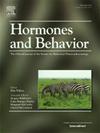Hormonal contraceptives during adolescence impact the female brain and behavior in a rat model
IF 2.5
3区 医学
Q2 BEHAVIORAL SCIENCES
引用次数: 0
Abstract
Millions of people take hormonal contraceptives (HCs), often starting during adolescence when ovarian hormones influence brain and behavioral maturation. However, there is a fundamental lack of information about the neurobehavioral consequences of hormonal alterations via adolescent HC use. To begin addressing this gap, we validated a rodent model of adolescent HC administration and characterized its impact on endocrine, transcriptional, and behavioral endpoints. Cohorts of intact post-pubertal female Sprague-Dawley rats received daily subcutaneous injections of either vehicle or HC [10 μg ethinyl estradiol (EE) + 20 μg levonorgestrel (LNG)] for the duration of adolescence from postnatal day (PND) 35 to PND56. Blood and brain tissue was collected at PND57. Other cohorts received daily injections of vehicle or HC from PND35 until behavioral assays were completed on PND57–64. HC treatment was effective, as vaginal lavage indicated disrupted estrous cycling and ELISA indicated suppressed serum luteinizing hormone in HC-treated rats. Liquid chromatography-mass spectrometry analysis showed EE and LNG in serum and brain as well as diminished serum and brain levels of allopregnanolone and testosterone in HC-treated rats. NanoString nCounter analysis indicated that adolescent HC administration impacted expression of genes related to synapses, white matter, neuroimmune, monoamine, and hormone signaling in the hypothalamus and medial prefrontal cortex. While no effects of HCs were seen on sociability in the social preference test or stress coping behavior in the forced swim test, adolescent HC administration diminished risk-assessment behaviors in the novelty-induced hypophagia paradigm and altered anxiety-like behavior in the open field test and elevated plus maze. Overall, these data suggest that exposure to contraceptive hormones during the critical developmental period of adolescence may shape the brain and behavior.
在大鼠模型中,青春期激素避孕药对女性大脑和行为的影响
数以百万计的人服用激素避孕药(hc),通常在青春期开始,因为卵巢激素影响大脑和行为的成熟。然而,关于青少年使用HC导致激素改变的神经行为后果的基本信息缺乏。为了开始解决这一差距,我们验证了青少年丙肝注射的啮齿动物模型,并表征了其对内分泌、转录和行为终点的影响。完整的青春期后雌性Sprague-Dawley大鼠队列每天皮下注射载体或HC [10 μg炔雌醇(EE) + 20 μg左炔诺孕酮(LNG)],从出生后第35天(PND)至PND56天。在PND57采集血液和脑组织。其他队列每天注射PND35的载体或HC,直到完成PND57-64的行为分析。HC治疗是有效的,阴道灌洗显示发情周期中断,ELISA显示HC治疗大鼠血清黄体生成素抑制。液相色谱-质谱分析显示,hc处理大鼠血清和脑内存在EE和LNG,血清和脑内异孕酮和睾酮水平降低。NanoString nCounter分析表明,青少年服用HC会影响下丘脑和内侧前额叶皮层突触、白质、神经免疫、单胺和激素信号相关基因的表达。虽然在社会偏好测试中的社交性和强迫游泳测试中的应激应对行为中未观察到HC的影响,但青少年服用HC降低了新奇性吞咽范式中的风险评估行为,改变了开放场测试和正迷宫中的焦虑样行为。总的来说,这些数据表明,在青春期的关键发育时期接触避孕激素可能会影响大脑和行为。
本文章由计算机程序翻译,如有差异,请以英文原文为准。
求助全文
约1分钟内获得全文
求助全文
来源期刊

Hormones and Behavior
医学-行为科学
CiteScore
6.70
自引率
8.60%
发文量
139
审稿时长
91 days
期刊介绍:
Hormones and Behavior publishes original research articles, reviews and special issues concerning hormone-brain-behavior relationships, broadly defined. The journal''s scope ranges from laboratory and field studies concerning neuroendocrine as well as endocrine mechanisms controlling the development or adult expression of behavior to studies concerning the environmental control and evolutionary significance of hormone-behavior relationships. The journal welcomes studies conducted on species ranging from invertebrates to mammals, including humans.
 求助内容:
求助内容: 应助结果提醒方式:
应助结果提醒方式:


